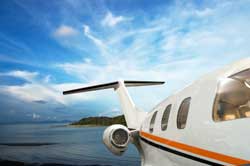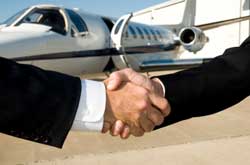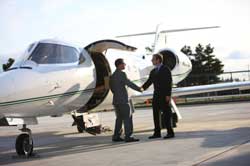Private Air Travel
Excluding Private Air Travel, usually when people tell you they enjoy traveling, what they really mean is that they enjoy wherever traveling gets them.
For many of us, the physical act of traveling is beset with delays, inconveniences, lost luggage, ticketing issues, and young children who — very vocally, if not articulately — capture our own feelings toward travel.
For those who can afford it, though, the option of private air travel offers a world where traveling doesn’t have to be a grim-but-necessary part of getting to your desired destination.
With private air travel, one has a greater control over the scheduling of one’s flights, and with more access to small, regional airports than commercial airlines, greater control of where your journeys can take you. Private air travel is a way to ensure that the gettingthere is as enjoyable as the there you’re getting to. |
 |
Once a niche market for only those who could afford a private jet ( ) of their own, private air travel has evolved to meet the new needs of a larger and more varied clientele.
Full ownership of private aircraft has given way to a more diverse marketplace of fractional ownership of private jets, private jet rentals and charters, and—most recently—the air taxi. These new options grew out of the realization that there were segments of the market whose interests could be best met with the benefits of private jets, but for whom the full ownership and upkeep of a private jet made little financial sense.
Fractional ownership is an alternative for those businesses and individuals whose private aircraft needs do not necessitate full ownership of a private aircraft but whose private air travel needs are nevertheless substantial and ongoing.
| With fractional ownership, a business or individual can purchase a set number of hours on a private aircraft of their choice without having to pay the higher costs associated with full ownership—including, in addition to the cost of the aircraft, the employment of a flight crew, maintenance staff, storage, etc. |  |
Still, fractional ownership represents a significant financial investment since the additional costs of crew, maintenance, fuel are often factored into the overall cost of the flight hours purchased, even though these fees are lower rates than full ownership faces.
For those whose travel needs are somewhat less demanding or less predictable, however, fractional ownership might present too costly a burden to be worth the investment. Private aircraft charters are a way to have the same control over your entire flight experience without making as large a financial commitment as fractional and full ownership pose.
Instead of purchasing a certain number of flight hours as one would with fractional ownership, the customer instead purchases access to a private jet on a trip-by-trip basis. Unlike commercial flights, the private air craft charter customer has more control over the scheduling of his flight, and many charters services can guarantee that a private jet rental will be ready with ten to twelve hours notice.
Where fractional ownership can sometimes lock the client into a block of flight time on a particular aircraft, the private jet rentals and aircraft charter allows the client to select the type of craft that best meets the needs of their particular trip.
And, as the world economy becomes increasingly interconnected, the rising costs of commercial business-class and first-class tickets on international flights coupled with reduction in service can make European air charters—as well as chartered flights to the business centers of Asia—the most cost effective choices for some businesses.
A number of private jet rental services have popped up in recent years, and customers must be wary. While many charter services offer an approximate range of cost per hour aboard a certain aircraft, some do not include certain surcharges which can change the price dramatically.
| For instance, taxes and some operational costs are often not included in these approximate quotes; although, for international and European air charters, the taxes are typically lower than private chartered flights within the United States. Another potential surcharge a prudent private charter customer should inquire about are repositioning charges. |  |
A repositioning charge, and the related “empty leg” charge, are the cost of moving a chartered private jet to the customer’s chosen point of departure if no jets from the charter service’s fleet are nearby.
Finally, with the rise of smaller, safer, and less expensive jets, a new service—air taxis—has begun to make headway in the private air travel market. The air taxis are designed for quick trips, and unlike fractional ownership plans and private air charters, where the individual or corporation rents the right to use the entire aircraft for some duration of time, air taxis allow the customer to purchase a single seat on these smaller, lightweight jets.
Forbes.com has suggested that this will be an increasingly dynamic part of the market as it blends together both the exclusivity of private jet rentals and the seat-by-seat ticketing of commercial airlines.
In an increasingly fluid marketplace, private air travel has morphed to meet the needs of different travelers, traveling for different purposes. And, different as the options may be, each attempts to offer the customer what made private air travel so attractive in the first place: greater freedom, control, convenience and pleasure.
Return from Private Air Travel to Air Travel Tips homepage




